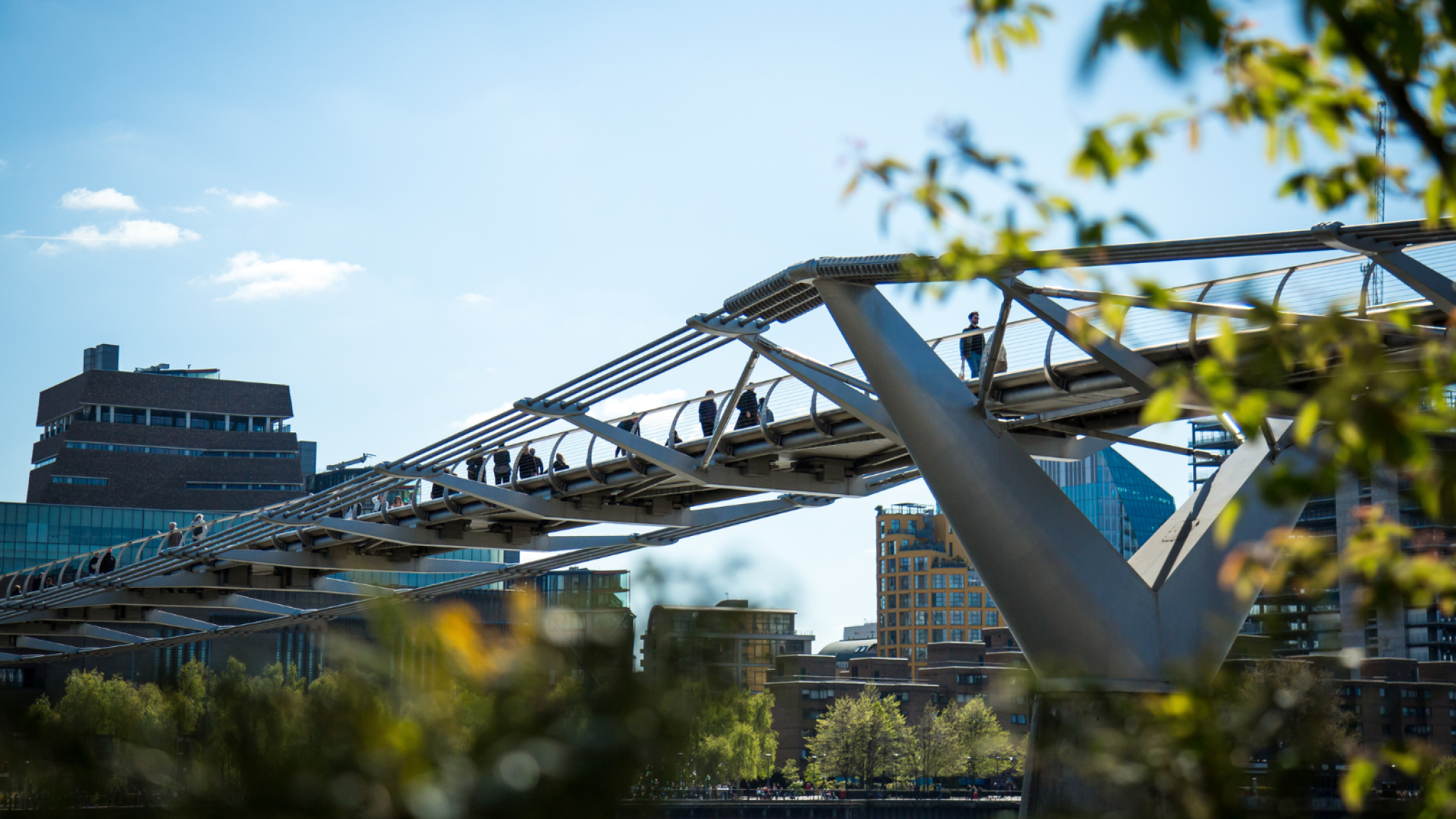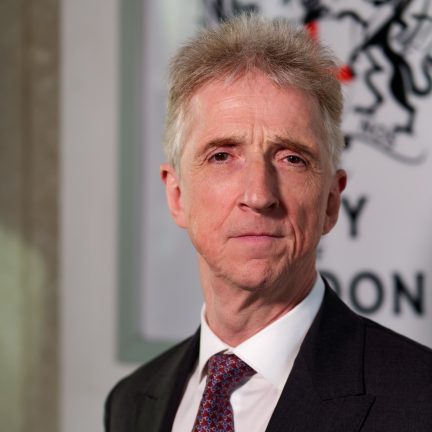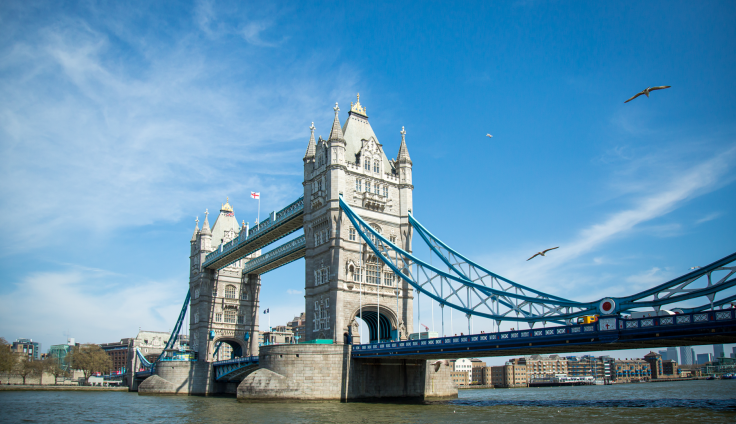
It’s 25-up for London’s iconic Millennium Bridge
A quarter of a century after it opened… and promptly closed, London’s most famous footbridge is celebrating its 25th birthday.

- Published: 5 June 2025
Millennium Bridge, which spans the Thames between St Paul’s Cathedral and the Tate Modern, was crossed by around 90,000 people on its opening day, June 10 2000.
But the gleaming landmark, designed to resemble a ‘blade of light’, was forced to close after three days due to an alarming swaying motion which saw it dubbed the ‘wobbly bridge’.
After having dampers fitted to stop the wobbling, the crossing reopened in February 2002 when responsibility for it passed to the 900-year-old City Bridge Foundation, which will mark the anniversary with a cake-cutting ceremony on the bridge.
From Tuesday 10 June, visitors to the bridge will be able to scan a QR code and listen to a specially written poem in tribute to the bridge, penned by the foundation’s poet-in-residence, Cecilia Knapp.

Paul Martinelli, City Bridge Foundation chair, said: “A quarter of a century after it opened, it’s now hard to imagine this stretch of the River Thames without Millennium Bridge, which has become a true London icon.
“Despite its teething troubles, the bridge has become firmly established in the hearts of Londoners, providing a very handy crossing point between two of the capital’s top tourist attractions, and a stunning backdrop to countless pictures.
“As a charity with 900 years of history behind us, we’re proud to have the youngest of all the Thames crossings among the five bridges we look after at no cost to the taxpayer.”
A competition for a new crossing over the Thames – the first since Tower Bridge over a century earlier – was launched by Southwark Council, the Royal Institute of British Architects and the Financial Times.
The winning entry, designed without tall suspension towers to avoid blocking the view of St Paul’s, was a partnership between architectural firm Foster + Partners, founded by Lord (Norman) Foster, the late sculptor Sir Anthony Caro and engineers Arup.
Lord Foster, Founder and Executive Chairman of Foster + Partners, said: “At the time of the competition for this bridge, my first sketch was for “a blade of light” – the most minimal intervention on the axis of St Paul’s. Its realisation as a collaboration between architecture, art and engineering has since transformed this quarter of London and opened up a fresh perspective on the River Thames. It demonstrates the power of connectivity to deliver social and economic benefits. We are grateful for this opportunity to extend the pedestrian network of London”.
Among those attending the ceremony on the bridge will be Chris Wise, who was part of the original team of engineers that designed the bridge. Chris, along with colleague Roger Ridsdill Smith, sketched out an early version of the ultra-minimalist concept on the back of a napkin in a central London wine bar.
He said: “We spent hours in there, sketching and sketching and trying to come up with an idea. We got more and more minimal until it was one line connecting the river from side to side. We took it to Norman [Foster] and straight away he said: ‘That’s it!’
“I was on the bridge on opening day with my son on my shoulders when it started to wobble. I did feel very responsible, but I don’t recall any sense of crisis – it was more fascination, what’s the problem and what can we do about it?
“I really enjoy seeing people walking across the bridge between St Paul’s and the Tate Modern – something they couldn’t do before. It’s great to have been involved in something that’s now part of the fabric of London.”
Roger Ridsdill Smith, Senior Partner and Head of Structural Engineering, Foster + Partners said: “I am very proud to have worked on the Millennium Bridge. Our design solution provided the most minimal means to span the Thames. The bridge hovers above the busy navigation channel while remaining low enough to preserve the protected views of St Paul’s Cathedral, thereby providing panoramic views of the city skyline from the deck, unimpeded by structure. It is a pleasure to see Londoners and visitors to the city crossing it, enjoying the view, and experiencing the wonderful destination that this part of London has become.”
The specially commissioned poem to mark the anniversary, All Around Us, Silver, includes a line from the poet John Donne – buried at St Paul’s Cathedral – and references the ‘blade of light’. The poem offers a different perspective, not structural, but emotional and reflective.

Cecilia Knapp, City Bridge Foundation poet-in-residence, said: “I’ve lived in London for most of my life and I still find that each time I cross the river, I find moments of joy and wonder. I seem to slow down a bit and take in my surroundings, and this is especially lovely on Millennium Bridge
“I wanted to capture this feeling in the poem, how crossing the bridge can be a moment of connection with the city and with each other, with art and with poetry. I’m excited that people can hear the poem out loud as they cross the bridge and hopefully have their own moment of connection.”
People can listen to the poem by scanning a QR code displayed on the bridge from Tuesday, 10 June 2025 onwards.
The poem, and an accompanying film produced by filmmaker Alexander Nicolaou, can be heard and viewed using the link below.
Millennium Bridge – 25 facts for 25 years
Wobbles, bundles of straw and a close encounter with Death Eaters – Millennium Bridge has packed a lot into its short life. Here are 25 facts to mark 25 years…
(1) A bridge spanning the Thames between St Paul’s Cathedral and Southwark was first mooted as long ago as the 1850s, with parliamentary approval finally granted in 1911.
(2) Bridges we could have had included an ornate stone structure featuring a carved winged goddess and a bridge with covered walkways and glass screens to protect pedestrians from the elements, both submitted in a 1913 competition.
(3) After the First World War, an attempt to revive the bridge idea was canned amid concerns its construction would disturb the foundations of the cathedral and, in the words of one MP, create ‘a vortex of noise with omnibuses crashing around St Paul’s.’
(4) The Millennium Bridge we know and love was the result of an architectural competition launched in 1996 by the Millennium Bridge Trust – set up to oversee the development of the new landmark – and promoted by the Financial Times, Royal Institute of British Architects and Southwark Council.
(5) The winning design was a partnership between architectural firm Foster + Partners – founded by renowned British architect Lord Foster – engineers Arup and sculptor Sir Anthony Caro.
(6) The bridge’s innovative ‘blade of light’ concept was designed by Lord Foster, and early sketches were drawn on the back of a napkin in a central London wine bar by engineers Chris Wise and Roger Ridsdill Smith.
(7) Construction began in late 1998 with the main works starting in April 1999, marked by a ceremony attended by deputy prime minister John Prescott, who said the structure would be ‘a beautiful bridge that will unite north and south London’.
(8) Millennium Bridge was the first new bridge over the Thames since Tower Bridge was built in 1894.
(9) The bridge is a steel suspension bridge for pedestrians, with its deck made of aluminium.
(10) The bridge is 325m long – roughly the length of three football pitches – 4m wide and sits 10.8m above the Thames at high tide.
(11) Unlike traditional suspension bridges, Millennium Bridge has no tall supporting towers, which would have blocked the iconic view of St Paul’s. Instead, it uses a shallow suspension design, with cables position on either side of the deck supported by piers in the river.
(12) Completion of work on the bridge was marked by a visit by the Queen, greeted with banners and fanfares, in a ceremony of dedication on Tuesday, May 9, 2000. She said: “I dedicate this bridge as a symbol of the new millennium to the people of Southwark and of the City of London and to all who shall pass over it from all over the world.”
(13) Celebrities attending the public opening on Saturday, June 10 included Paul McCartney’s (at the time) new partner Heather Mills, newsreader Julia Somerville, Coronation Street actor Chris Bisson and ‘H’ from Steps.
(14) The bridge was designed to connect the Tate Modern art gallery on the South Bank directly with St Paul’s Cathedral and the City of London on the North Bank, creating a significant new pedestrian route.
(15) The bridge opened on a Saturday; access was restricted on Sunday due to the swaying and the bridge closed indefinitely on Monday evening for a full investigation.
(16) Bridge boffins discovered the wobbling was due to ‘synchronous lateral excitation’ – in which people subconsciously adjust their step to the bridge’s natural swaying motion, making it sway even more.
(17) It remained closed for 18 months to allow dampers, which work a bit like the shock absorbers in a car, to be fitted underneath to stop the bridge from wobbling.
(18) Ownership of the bridge transferred to the ancient charity City Bridge Foundation on February 22 – the same day it finally reopened to the public – bringing up to five the number of bridges the foundation looks after at no cost to the taxpayer.
(19) The first member of the public to set foot on the bridge after it reopened was 91-year-old Emma Drake, from Highbury, one of those forced to turn back on her maiden crossing. “It’s wonderful to be on the bridge,” she proclaimed.
(20) In April 2007, 600 people on space hoppers bounced simultaneously on Millennium Bridge for 60 seconds, breaking the world record for the biggest hop.
(21) The bridge has appeared in films including Guardians of the Galaxy, Run Fatboy Run and, most famously, Harry Potter and the Half Blood Prince, when it was destroyed by Death Eaters.
(22) In October 2023, City Bridge Foundation carried out work to replace the membrane which separates the aluminium bridge deck and the steel structure.
(23) During the work, a bundle of straw was hung from the bridge as a warning to shipping, in accordance with the Port of London Thames Byelaws, a story which attracted international media attention.
(24) There are many other Millennium Bridges including those in Gateshead, Glasgow, Lancaster, Salford and York; Millennium Bridge in Dublin, Puente del Milenio in Orense, Spain, and Most Milenijum in Podgorica, Montenegro.
(25) But the one in London is the best, obviously.
